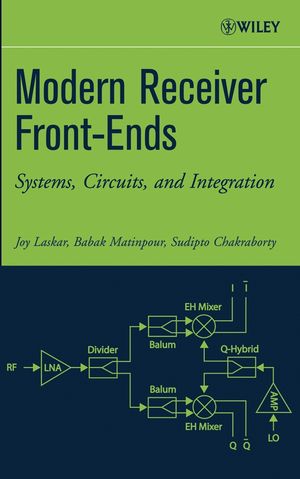Modern Receiver Front-Ends: Systems, Circuits, and IntegrationISBN: 978-0-471-22591-1
Hardcover
240 pages
February 2004
 This is a Print-on-Demand title. It will be printed specifically to fill your order. Please allow an additional 10-15 days delivery time. The book is not returnable.
|
||||||
Acknowledgments.
1 INTRODUCTION.
1.1 Current State of the Art.
2 RECEIVER SYSTEM DESIGN.
2.1 Frequency Planning.
2.1.1 Blockers.
2.1.2 Spurs and Desensing.
2.1.3 Transmitter Leakage.
2.1.4 LO Leakage and Interference.
2.1.5 Image.
2.1.6 Half IF.
2.2 Link Budget Analysis.
2.2.1 Linearity.
2.2.2 Noise.
2.2.3 Signal-to-Noise Ratio.
2.2.4 Receiver Gain.
2.3 Propagation Effects.
2.3.1 Path Loss.
2.3.2 Multipath and Fading.
2.3.3 Equalization.
2.3.4 Diversity.
2.3.5 Coding.
2.4 Interface Planning.
2.5 Conclusion.
3 REVIEW OF RECEIVER ARCHITECTURES.
3.1 Heterodyne Receivers.
3.2 Image Reject Receivers.
3.2.1 Hartley Architecture.
3.2.2 Weaver Architecture.
3.3 Zero IF Receivers.
3.4 Low IF Receivers.
3.5 I ssues in Direct Conversion Receivers.
3.5.1 Noise.
3.5.2 LO Leakage and Radiation.
3.5.3 Phase and Amplitude Imbalance.
3.5.4 DC Offset.
3.5.5 Intermodulations.
3.6 Architecture Comparison and Trade-off.
3.7 Conclusion.
4 SILICON-BASED RECEIVER DESIGN.
4.1 Receiver Architecture and Design.
4.1.1 System Description and Calculations.
4.1.2 Basics of OFDM.
4.1.3 System Architectures.
4.1.4 System Calculations.
4.2 Circuit Design.
4.2.1 SiGe BiCMOS Process Technology.
4.2.2 LNA.
4.2.3 Mixer.
4.2.4 Frequency Divider.
4.3 Receiver Design Steps.
4.3.1 Design and Integration of Building Blocks.
4.3.2 DC Conditions.
4.3.3 Scattering Parameters.
4.3.4 Small-Signal Performance.
4.3.5 Transient Performance.
4.3.6 Noise Performance.
4.3.7 Linearity Performance.
4.3.8 Parasitic Effects.
4.3.9 Process Variation.
4.3.10 50-Ω and Non-50-Ω Receivers.
4.4 Layout Considerations.
4.5 Characterization of Receiver Front-Ends.
4.5.1 DC Test.
4.5.2 Functionality Test.
4.5.3 S-Parameter Test.
4.5.4 Conversion Gain Test.
4.5.5 Linearity Test.
4.5.6 Noise Figure Test.
4.5.7 I/Q Imbalance.
4.5.8 DC Offset.
4.6 Measurement Results and Discussions.
4.6.1 Close Examination of Noise Figure and I/Q Imbalance.
4.6.2 Comments on I/Q Imbalance.
4.7 Conclusion.
5 SUBHARMONIC RECEIVER DESIGNS.
5.1 Illustration of Subharmonic Techniques.
5.2 Mixing Using Antisymmetric I–V Characteristics.
5.3 Impact of Mismatch Effects.
5.4 DC Offset Cancellation Mechanisms.
5.4.1 Intrinsic DC Offset Cancellation.
5.4.2 Extrinsic DC Offset Cancellation.
5.5 Experimental Verification of DC Offset.
5.6 Waveform Shaping Before Mixing.
5.6.1 Theory and Analysis.
5.6.2 Experimental Verification on GaAs MESFET APDP.
5.6.3 Implementation in Silicon.
5.7 Design Steps for APDP-Based Receivers.
5.8 Architectural Illustration.
5.9 Fully Monolithic Receiver Design Using Passive APDP Cores.
5.9.1 Integrated Direct Conversion Receiver MMIC’s.
5.9.2 Receiver Blocks.
5.9.3 Additional Receiver Blocks.
5.10 Reconfigurable Multiband Subharmonic Front-Ends.
5.11 Conclusion.
6 ACTIVE SUBHARMONIC RECEIVER DESIGNS.
6.1 Stacking of Switching Cores.
6.1.1 Description and Principles.
6.1.2 Subharmonic Receiver Architecture.
6.2 Parallel Transistor Stacks.
6.2.1 Active Mixer.
6.2.2 Receiver Architecture.
6.2.3 Extension to Passive Mixers.
6.3 Extension to Higher-Order LO Subharmonics.
6.4 Multiple Phase Signal Generation from Oscillators.
6.5 Future Direction and Conclusion.
7 DESIGN AND INTEGRATION OF PASSIVE COMPONENTS.
7.1 System on Package (SoP).
7.1.1 Multilayer Bandpass Filter.
7.1.2 Multilayer Balun Structure.
7.1.3 Module-Integrable Antennaw.
7.1.4 Fully Integrated SoP Module.
7.2 On-Chip Inductors.
7.2.1 Inductor Modeling.
7.2.2 Inductor Parameters.
7.2.3 Application in Circuits.
7.3 Capacitors.
7.4 Differentially Driven Inductors.
7.5 Transformers.
7.5.1 Electrical Parameters.
7.5.2 Physical Construction.
7.5.3 Electrical Models.
7.5.4 Frequency Response of Transformers.
7.5.5 Step-Up/Step-Down Transformers and Circuit Applications.
7.6 On-Chip Filters.
7.6.1 Filters Using Bond Wires.
7.6.2 Active Filters.
7.7 On-Wafer Antennas.
7.8 Wafer-Level Packaging.
7.9 Conclusion.
8 DESIGN FOR INTEGRATION.
8.1 System Design Considerations.
8.1.1 I/O Counts.
8.1.2 Cross-Talk.
8.1.3 Digital Circuitry Noise.
8.2 IC Floor Plan.
8.2.1 Signal Flow and Substrate Coupling.
8.2.2 Grounding.
8.2.3 Isolation.
8.3 Packaging Considerations.
8.3.1 Package Modeling.
8.3.2 Bonding Limitation.
8.4 Conclusion.
9 FUTURE TRENDS.
9.1 CMOS Cellphones.
9.2 Multiband, Multimode Wireless Solutions.
9.3 60 GHz Subsystems in Silicon!
9.4 Interchip Communications.
9.5 Ultrawideband Communication Technology.
9.6 Diversity Techniques.
9.7 Conclusion.
Index.



